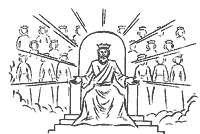We need to know some of the basic principles, so that every
reader can see for themselves the best way to interpret this book.
Due to the fact that John describes so many dramatic events, both symbolically
as well as in the literal sense, it makes this book very confusing for many.
It is the will of God that every person is aware of the time plan of God which
He has for this world system.
Revelation 1,3 “Blessed is he that readeth, and they that hear the words
of this prophecy, and keep those things which are written therein: for the time
is at hand.”
Let us take a look at several things: We can only firstly learn from what the
Holy Scriptures have to say when we are also ready to believe them.
· The prophets of God who we find in the Bible are not just stating their
own opinions, but rather, they spoke and wrote down things about the future
for us, as the Holy Spirit inspired them to do so (2. Pet. 1,19-21). Daniel
received many of his revelations through visions and dreams (Dan. 2,19 + 7,1).
Some things which are written in the book of Revelation were already prophesied
beforehand, and therefore, it was nothing new for John, being a Jew. In addition,
the symbolic language which John uses is not so difficult to understand. The
key is found in Revelation 1,19: the things which are, and the things which
shall be hereafter…
Various passages help us to understand the contents of this book better. In
the following lessons, we will be dealing with the individual themes:

1. First of all, the church of Christ on earth (1,11), is subsequently raptured
into heaven and is in His presence (7,9), up until the time that she will return
again with Him back to earth (19,14).
2. They describe how God takes on the Jewish people again and preserves the
believers among them from the second death, up until the end (7).
3. We see how the time of tribulation begins on earth and what takes place in
the invisible world.
4. The reactions of the people as a result of the plagues (9,21).
5. The appearance, ruling and reigning of the antichrist up until his final
end.
6. His end takes place at the battle of Megiddo when Jesus returns again with
His saints. Here, in the valley of Jesreel, God will gather the nations, in
order to judge them. The fallen angel Lucifer will also be thrown into the fiery
pit with all those who belong to him (20,6).
7. The next thing after that is the description of how Jesus transfers his heavenly
kingdom for a thousand years upon this earth. Jerusalem is the capital city.
The remaining people of the human race experience how Jesus rules with those
who belong to him (20,6).
8. After this period of a thousand years Lucifer is let loose again, in order
to test the human race to see who they will choose. Not having learnt from their
past, they reject Jesus Christ again, and set out again against Jerusalem (20,9).
Now God judges them with fire.
9. The passage which is just before the end has to do with the great white throne,
which means that God’s holy judgment will be executed over all wickedness,
and everything in connection with evil will receive its righteous reward. Hell,
the sea and earth will be compelled to give up the remaining dead people; they
will all stand before him and be judged as according to their works (20,11-15).
10. At the end, we see the passing away of the present world system, with all
that is in it, and experience the rising of a new heaven and a new earth which
God has spoken into existence (21,1). We discover the existence of genuine unity,
law and freedom within.
Many who interpret this book make the mistake of not taking
into consideration the spans of time in which these things take place. Although
Jesus gives John the exact details concerning these things.
1.) The dispensation of grace (about 2000 years), the present time. His church
is still on this earth. Many are already asleep, however, they will rise again
at the Second Coming of Jesus when He comes to take His people away from this
earth. We are standing directly at the door of this event.
2.) Starting from the fourth chapter, verse 1, the last prophetic week breaks
forth, which comprises of a period of  seven
years which God has chosen. During this dispensation Jesus turns towards his
people Israel again. Within these 7 years the terrible time of the appearing
of the antichrist and the works which he does takes place. In the course of
that particular time the anger and the judgment of God over mankind who continually
reject Him is revealed. The period of 7 years ends with the visible Second Coming
of Jesus and his saints to earth.
seven
years which God has chosen. During this dispensation Jesus turns towards his
people Israel again. Within these 7 years the terrible time of the appearing
of the antichrist and the works which he does takes place. In the course of
that particular time the anger and the judgment of God over mankind who continually
reject Him is revealed. The period of 7 years ends with the visible Second Coming
of Jesus and his saints to earth.
It is important to realise that the above mentioned 7 years have not yet began.
They will firstly begin when the church is raptured from the earth. Therefore,
it is nonsense to say that it is already here. These 7 years are to be taken
in the literal sense and not symbolically. Firstly after 7 years will the 1000
year kingdom of Jesus on earth break forth. These particular periods of times
have not yet come, but they are lying ahead of mankind .rw


 666
666  1. First of all, the church of Christ on earth (1,11), is subsequently raptured
into heaven and is in His presence (7,9), up until the time that she will return
again with Him back to earth (19,14).
1. First of all, the church of Christ on earth (1,11), is subsequently raptured
into heaven and is in His presence (7,9), up until the time that she will return
again with Him back to earth (19,14).  seven
years which God has chosen. During this dispensation Jesus turns towards his
people Israel again. Within these 7 years the terrible time of the appearing
of the antichrist and the works which he does takes place. In the course of
that particular time the anger and the judgment of God over mankind who continually
reject Him is revealed. The period of 7 years ends with the visible Second Coming
of Jesus and his saints to earth.
seven
years which God has chosen. During this dispensation Jesus turns towards his
people Israel again. Within these 7 years the terrible time of the appearing
of the antichrist and the works which he does takes place. In the course of
that particular time the anger and the judgment of God over mankind who continually
reject Him is revealed. The period of 7 years ends with the visible Second Coming
of Jesus and his saints to earth.